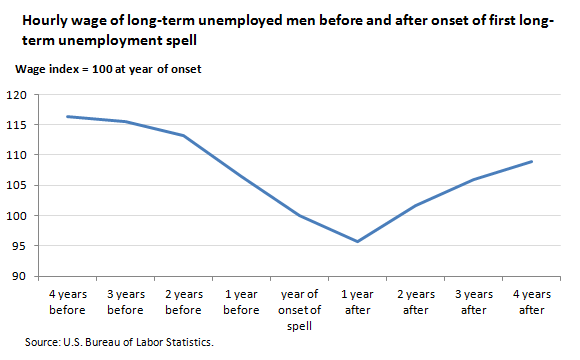An official website of the United States government
 United States Department of Labor
United States Department of Labor
Men experiencing their first long-term unemployment spell—a spell lasting 27 weeks or longer—saw a sharp decrease in their average hourly wage in the calendar year before that long-term unemployment spell. In the year the first long-term unemployment spell started, the average hourly wage was about 13 percent lower (adjusted for inflation) than the average hourly wage 2 years before the first long-term spell.

| Year | Hourly wage index |
|---|---|
4 years before | 116.3 |
3 years before | 115.6 |
2 years before | 113.2 |
1 year before | 106.4 |
year of onset of spell | 100.0 |
1 year after | 95.7 |
2 years after | 101.7 |
3 years after | 105.9 |
4 years after | 108.9 |
In the first calendar year after onset of the first long-term unemployment spell, real average hourly wages continued to fall by about 4 percent. Average hourly wages then trended back up in the following years. However, real average hourly wages were about 7 percent lower 4 years after the onset of the long-term unemployment spell than they were 4 years before the long-term spell.
In contrast, men who did not experience a long-term unemployment spell had very significant wage growth over time. For example, over the 8-year period from 1990 to 1998, men who never had a long-term unemployment spell experienced a 41-percent increase in their real hourly wages, on average.
These data are from the National Longitudinal Surveys program. To learn more, see “Long-term unemployment over men’s careers,” (HTML) (PDF), by Donna S. Rothstein in Beyond the Numbers, August 2013. The article uses the employment history of men in the National Longitudinal Survey of Youth 1979 (NLSY79). The men in the NLSY79 were born in the years 1957 to 1964. The analysis covers the mid-1980s through 2009, focusing on men’s employment histories from their mid-20s, after they had become integrated into the labor market, until their middle to late 40s and early 50s.
Bureau of Labor Statistics, U.S. Department of Labor, The Economics Daily, Men's wages before and after long-term unemployment spells at https://www.bls.gov/opub/ted/2013/ted_20130906.htm (visited November 01, 2025).

